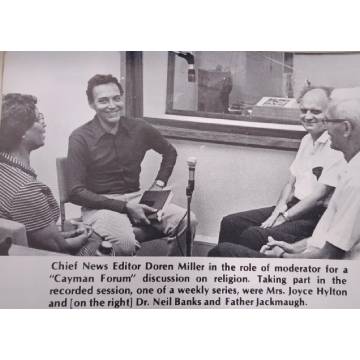News
RCIPS Reminds Motorists to Practice Defensive Driving

The RCIPS is aware of a video circulating on social media which shows a collision on Shamrock Road, involving a red car and a white van. The red vehicle was travelling across Shamrock Road onto Pedro Castle Road, and a white van was travelling westbound on Shamrock Road, passing Pedro Castle Road, when the collision occurred. Police responded at the time of the incident and spoke to the drivers of both vehicles. The matter is currently under investigation.
“While no one was injured in the collision, this is one of those cases which highlights the importance of defensive driving, as the outcome could have been much different otherwise,” says Superintendent Roje Williams. “We’d like to remind the public that while it is always important to avoid those driving behaviours which are against the law, such as speeding, distracted driving and driving under the influence, all motorists should also do their best to practice defensive driving.”
Driving defensively entails being aware of what is going on on the road around you, particularly ahead of your vehicle. It also means giving yourself enough space and time to respond to any unexpected occurrence.
- Stay Focused: Keep your attention on the road and your surroundings eg: driveways and intersections, persons on sidewalks, and other road users eg: cyclists, runners, children.
- Prepare Before Starting the Ignition: Is your seat in the correct position, are your mirrors adjusted, is your seatbelt on? Always have both hands on the steering wheel in the 10-to-2 position. This enables you to have greatest control of the vehicle – especially if you have to react quickly.
- Safe Following Distance: Maintain a reasonable distance between your vehicle and the vehicle in front of you. Leave approximately two car lengths to allow adequate stopping time.
- Use Turn Signals: Give other drivers a clear indication of your intentions before you make a turn. This helps prepare motorists for your maneuver, eliminating ambiguity and helping avoid collisions.
- Obey Speed Limits: Observing speed limits can prevent accidents caused by excessive speed. Speed limits are set to suit the nature of the road and its surroundings eg: tight turns, hidden driveways, high density of children, schools etc. Always obey the speed limit so that you are best prepared to manage the characteristics of each roadway.
- Scan for Hazards: Continuously scan the road for potential hazards. Look ahead so you can anticipate what is coming up so you are prepared to respond with adequate time.
- Avoid Aggressive Driving: Be calm and in control of your emotions while driving. Running late is not an excuse to speed or pressure other drivers on the road by following too close, or passing in an unsafe manner.
- Weather Awareness: Make adjustments to your driving based on the weather. When rain begins, increase your following distance to allow increased braking distance. In inclement weather, maybe consider rescheduling your trip entirely.
- Understand Right of Way: Ensure that right-of-way rules are followed to prevent collisions. The main road has right of way over traffic entering from a side road. Don’t edge out into oncoming traffic. And always give way to persons coming from the right on a round-a-bout.
- Vehicle Maintenance: Keep your car well-maintained to avoid breakdowns, or vulnerabilities eg: tires with low tread will skid further in rain or when sudden braking is required.
“Most importantly, you should not assume that everyone else will be using the road responsibly or safely, but be alert and ready to anticipate or react to any erratic road usage you may be faced with,” adds Superintendent Williams.












